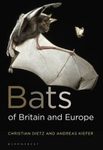About this book
This revised edition of a book first published in 2010 supplements the original account of the 116 bat species then known to be found in Southern and Central Africa with an additional eight newly described species. The chapters on evolution, biogeography, ecology and echolocation have been updated, citing dozens of recently published papers. The book covers the latest systematic and taxonomic studies, ensuring that the names and relationships of bats in this new edition reflect current scientific knowledge. The species accounts provide descriptions, measurements and diagnostic characters as well as detailed information about the distribution, habitat, roosting habits, foraging ecology and reproduction of each species. The updated species distribution maps are based on 6,100 recorded localities.
A special feature of the 2010 publication was the mode of identification of families, genera and species by way of character matrices rather than the more generally used dichotomous keys. Since then these matrices have been tested in the field and, where necessary, slightly altered for this edition. New photographs fill in gaps and updated sonograms aid with bat identification in acoustic surveys. The bibliography, which now contains more than 700 entries, will be an invaluable aid to students and scientists wishing to track down original research.
Contents
FOREWORD TO THE FIRST EDITION
FOREWORD TO THE SECOND EDITION
ACKNOWLEDGEMENTS
INTRODUCTION
Geographical scope
Classification and taxonomy
Conservation status
MUSEUM COLLECTIONS AND PIONEERING RESEARCHERS
Researcher gallery
The value of specimens
Chiroptera collections
Databases and author’s contributions
BAT BIOLOGY
Overview
Migration
Torpor and hibernation
Reproduction
Predation
Foraging ecology and associated ecological services
Roosting habits
Foliage-roosting bats
Hollow-roosting bats
Crevice-roosting bats
Specialised roost sites
BIOGEOGRAPHY
Geology
Ancient basement rocks
Sedimentary rocks
Rift valleys
Geomorphology
Escarpments
Drainage systems
Climates past and present
Vegetation
Grassland
Savanna
Forest
ECHOLOCATION
Echolocation systems
Types of bat echolocation pulses
Ecology of bat echolocation and flight
Recording echolocation calls
Spectrum analysis
Bat detectors
Spectrograms and echolocation
SPECIES ACCOUNTS
Suborder Pteropodiformes
Pteropodidae
Hipposideridae
Rhinonycteridae
Rhinolophidae
Megadermatidae
Suborder Vespertilioniformes
Emballonuridae
Nycteridae
Molossidae
Miniopteridae
Cistugidae
Vespertilionidae
GLOSSARY
LIST OF SPECIMENS
REFERENCES
INDEX
Customer Reviews
Biography
Ara Monadjem is Professor in the Department of Biological Sciences at the University of eSwatini, where he has been lecturing in zoology for the past 26 years. Peter John Taylor is Professor in the School of Mathematical and Natural Sciences at the University of Venda. Fenton (Woody) Cotterill is a Research Fellow with the National Geographic Okavango Wilderness Project. M Corrie Schoeman is Honorary Associate Professor in the School of Life Sciences at the University of KwaZulu-Natal.































